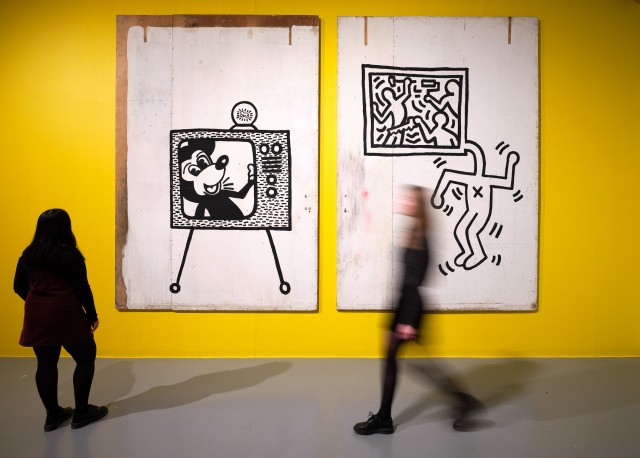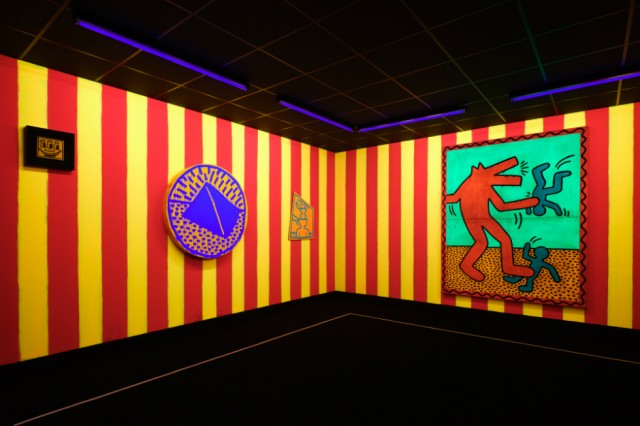“Art, activism, club life and pop culture.” Keith Haring – Reviewed
![Joseph Szkodzinski Keith Haring Drawing Series [02]](http://www.thedoublenegative.co.uk/blog/wp-content/uploads/2019/06/Joseph-Szkodzinski-Keith-Haring-Drawing-Series-02.jpg)
As Tate Liverpool stage the first major UK exhibition of Keith Haring’s work in the UK, Vicky Andrews considers his impact as artist and activist…
“I’m at the Tate gallery…we’ve just been in a clubbing room!” the woman shouted into her mobile phone outside one of the installations. All around, visitors were snapping photos of and with the artwork, vast colourful canvases of vivacious shapes and symbols. I wondered what Keith Haring would think about our 21st century obsession with technology; I think he’d probably like it.
Haring was one of the most important artists and social activists of his time whose radiant and provocative work reflects the politically charged era of Ronald Reagan’s America. Even if you don’t know his name, you’ll be familiar with his unique drawing style and repeated motifs that include outlined figures, barking dogs and radiant babies. At first glance the symbols look simple and one dimensional, but they reveal an intense emotional backdrop to his creative energy with recurring themes of love, sex, compassion, fear, birth and death.
For Tate Liverpool to host the first major exhibition of his work in the UK is a massive win for Merseyside. The privilege comes with an entry fee in excess of a tenner which might raise a few eyebrows; Haring famously advocated the idea of art for everybody. But it’s a fully immersive experience that deserves a good 90 minutes to fully appreciate the context behind his work. Whether you’re a child of the 80s or not, the exhibition is an Aladdin’s Cave for the sugar-coated decade that gave us MTV and nuclear paranoia.
There are more than 85 objects on display, including video and sound clips, following a loose chronological order that covers Haring’s passion for art, activism, club life and pop culture. The big psychedelic pieces are at once playful and provocative, exhilarating to see in such an intimate setting, and enhanced by a wealth of archive materials dotted around that add background to the stories behind them: press releases, club flyers, party invites, magazine covers, record sleeves and fashion from his collaborations with Grace Jones, Madonna, Malcolm McClaren and Vivienne Westwood.

Work from his early years as an artist includes Disney-inspired cartoons that are cute and sinister at the same time, a precursor to the good versus evil conflict that occurs repeatedly in later life. Video footage from Painting Myself Into A Corner shows Haring meticulously drawing onto a surface under his bare feet, hopping from corner to corner until eventually he has nowhere left to go. His work is as much about the performance as the painting itself and it’s a captivating insight into the artistic process that filled me with anxiety as I watched to see if he’d escape his own self-defined borders.
Later works include a figure with the head of a fish taking a half-human television from behind; spotted dogs run riot through a man’s torso; tiny men ride on the back of a dragon ghetto blaster; a caterpillar with the head of a computer tramples across headless bodies trying to escape its captor. UFOs attack animals, buildings and people. Frivolity and fun become chaos and the advance of technology quickly turns into fear.
Photographs of Haring riding the city subway and hanging out in his neighbourhood, are a touching reminder of his geeky normality. His early chalk drawings and graffiti art appeared on blank spaces across New York City, from station walls, advertising hoardings and abandoned buildings to the mangled hood of a yellow taxi cab. He enjoyed talking to people about his drawings as he created them and said: “This was the first time I realised how many people could enjoy art if they were given the chance. These were not the people I saw in the museums or in the galleries, but a cross-section of humanity that cut across all boundaries.”
Bridging the gap between art and popular culture is a recurring theme. In 1982, Haring transformed the basement of Soho’s Shafrazi Gallery into a club with fluorescent day-glo paintings presented under UV light and soundtracked by a hip hop DJ. The Blacklight Room (below) is one of this exhibition’s highlights, a playful circus of red and yellow stripes centred around an angry ‘barking dog’ piece in neon shades of green and red. No photos inside the installation please, but you’re more than welcome to give your mate a call after to ask if they want a t-shirt, record or button badge from the gift shop. Inspired by Haring’s Pop-Shop boutique in downtown Manhattan, Keith would most definitely approve.

The work is full of fun, but his creative direction was driven much more by his interest in social issues and political agenda than his pop artist friend and mentor, Andy Warhol. He wanted to use art for good and his fight for positive change is preserved through some wonderful hand drawn posters for the African Emergency Relief Fund, Crack Down (alongside the Crack is Wack mural) and an anti-nuclear rally in Central Park. He was a vocal campaigner for nuclear disarmament and in 1988 visited Hiroshima, devastated by atomic bombs in the Second World War. The photographs he saw reduced him to tears and he said that they were “nothing short of science-fiction horror.”
The last room of the exhibition focuses on Haring as an openly gay man and his work as an AIDS activist, LGBT educator and safe sex campaigner. It’s a poignant final section with emotive footage of protests against the US government alongside Haring’s iconic 1989 piece, Silence = Death, which reveals how the pink triangle was reclaimed from Nazi concentration camps to become a symbol of LGBT pride.
Haring was a radical artist who introduced themes of homosexuality, safe sex and AIDS awareness into art and popular culture at a time when few people wanted to acknowledge them, much less confront such issues head on. In 1987, he wrote, “I am quite aware of the chance that I have or will have AIDS. In fact, the symptoms already exist. My friends are dropping like flies and it is only divine intervention that’s kept me alive this long. I don’t know if I have five months or five years, but I know my days are numbered.”
In 1989, he established the Keith Haring Foundation to continue his social outreach and activism in support of those affected by HIV and AIDS. He died in 1990 at the age of 31. His career was short, but he packed a lot in, and we can learn much from his dream to inspire people on the streets to change the world. As we mark the 50th anniversary of the Stonewall uprising, Keith Haring’s legacy is an essential piece of our history; don’t miss out on this chapter.
Vicky Andrews
Keith Haring continues @ Tate Liverpool until 10 November – £12.50/Concs
Images, from top: Joseph Szkodzinski, Keith Haring Drawing Series, January 1982 © Joseph Szkodzinski;Untitled 1982; Untitled 1982, Untitled 1981, Untitled (Russian Doll) 1982 and Untitled 1982 on display in Keith Haring at Tate Liverpool from 14 June – 10 November © Mark McNulty





